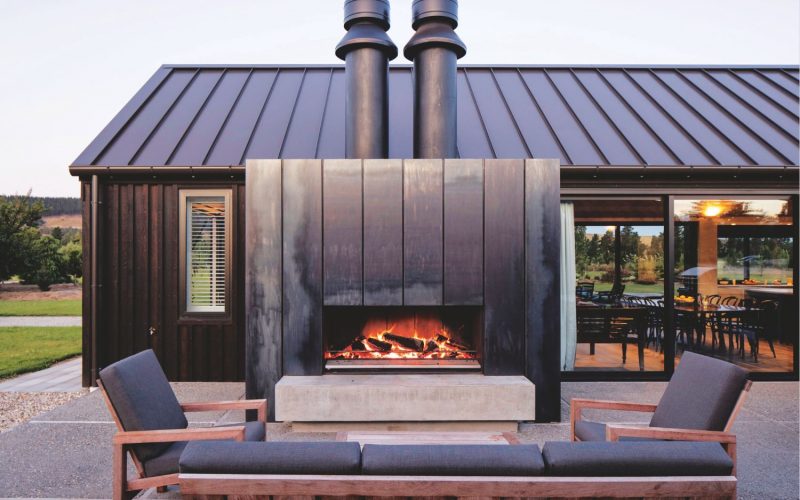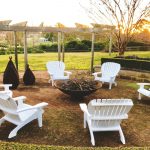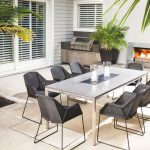From cosy wood-burning fire pits to wall-mounted radiant heaters, there is no shortage of ways to generate some winter warmth
Words: Karen Booth
Some form of outdoor heating is now de rigueur but what you choose and where you place it depends on how you plan to use your garden and outdoor entertaining areas. If you want to spark lively conversation, a fire pit encircled by stools might be ideal but if you want a quiet space in which to relax after a meal, a built-in fireplace might better suit.
It’s not just where you want the heat, though; it’s how much you want and how much maintenance you’re prepared to do. Electric, gas and bioethanol heaters can be turned on and offer with the flick of a switch while those that burn wood need to have that fuel source constantly replenished then the ash and cold embers cleared away afterwards.
As for ambience, do you want dancing flames without the crackle? If so, bioethanol or gas fireplaces will suffice but for many, the pop of real flames and aroma of woodfire makes the extra effort worth it.

Fit for purpose
“It’s important to consider outdoor heating up front,” says Levi Carter, design manager at Fifth Season Landscapes. “As garden designers we’re always aiming to create a comfortable space for people to spend time in, especially when it comes to outdoor living. Comfort directly relates to function and through heating we’re able to activate a space at night, or in the colder months, that may otherwise have been unusable.”
Aaron Worth of Utopian Landscape Design agrees. “Whether you’re in a cold or temperate climate, heating is a crucial consideration when designing a garden as it either extends the usable timeframe of the space or allows year-round use. Outdoor fire pits and fireplace are also often employed for their aesthetic value as design features that can be appreciated at all times of the year.
“When deciding which heating solution to use, consider what role the heating is to play and which space is to be heated,” he continues. “For example, a fire pit is the quintessential bush television and is the perfect centrepiece in a space where you want people to gather, sit and chat.”
“Before making a decision, spend time in the space and think about how the area you’re looking to heat connects to the house and surrounding garden,” adds Levi. “Are you heating an outdoor room with all the creature comforts or a place under the stars where you want to feel removed from the hustle and bustle of urban living?”

Think creatively
There is no shortage of creative ways to keep warm outside. You could carve out a corner of your garden, replace that section of lawn with gravel, place a fire pit in the centre and surround it with log stools or bench seats. You might like to part-screen this area with leafy plants to make it cosier.
Or go the other way. Introduce two or three wide steps leading up to a paved area of the garden where a fire pit or fireplace of some description takes pride of place. Surround the area with a low wall that gives definition to the space, and can be used as seating, add some chairs and a coffee table and you have a room-like space that draws people into the garden.
A fireplace can become a design focal point by integrating it into a feature wall in an outdoor room or covered patio. Better yet, why not recess a storage niche into the wall or add a storage ledge? If the goal is to make the heating unobtrusive, that can be easily achieved, too. Slimline electric heaters can be mounted on the ceiling or high on the wall of a covered outdoor space.
Of course, fire pits can be a focal point or design feature in their own right and used as much as a decorative item as a source of warmth. Some are clean-lined and modern, others ornate. Some look like shallow bowls, others more like cauldrons. The design of the legs or stands varies, too, and some might even incorporate wood storage space.

Fan those flames
Of all outdoor heating forms, the fire pit seems to be the one that has really captured our attention. “Today, people have a greater appreciation of outdoor entertaining and the use of a fire pit adds warmth and visual beauty to conversation areas, encouraging you to gather and relax,” says Helen Neyland of Entanglements. “More than ever, people are appreciating that having a cosy fire pit area is great for socialising with friends and family or providing a reprieve from the busyness of everyday living.
“Fire pits with a rust finish remain the most popular choice as the rust colour complements Australian plant schemes, as well as adding character and textural beauty to an outdoor living space,” she continues. “And while wood-fuelled fire pits are still very popular, we’re seeing more people wanting to incorporate one of our stainless bioethanol burners into their fire pits. The ethanol burner generates clean air and a 2.5L tank lasts about eight hours.”
Says Levi, you can also have a gas feed installed into a fire pit to minimise mess and maintenance. “A fire pit can create a great destination point within the garden and a relaxed night-time environment,” he adds, “and a small fire pit that’s movable is great in an area where space is at a premium.”
Enduring solutions
For those who have the space, budget and inclination — and who want a permanent heating solution — a built-in wood-burning fireplace can be a lifestyle asset. A crackling fire draws people in and a custom-built fireplace set into a feature wall really anchors an outdoor design.
The fireplace surrounds and chimney can be built of stone or clad in stone veneers if you want to achieve a rustic look at an affordable price. “As a heating element that also provides scale and impact, it’s hard to go past the traditional fireplace. If you have an outdoor room and can fit one in, do it,” says Levi.
Gas and bioethanol fireplaces can also be permanent fixtures and built into the wall of an outdoor room or a freestanding feature wall that, if perfectly positioned, can serve as a means of giving privacy from neighbours. One of the advantages of building a gas- or bioethanol-fuelled fireplace into a wall is that no flue will be required, although any gas heater needs to be located in a well-ventilated space.
If what you’re after is more of a in-the-bush campfire-style experience, consider a built-in fire pit. They can be set into the ground or elevated and set within a square or round structure that brings the flames to the right height for warming hands. Build them with a wide ledge so that you can rest drinks and snacks on them. For a countrified, more natural look, use brick, stone or masonry clad in stone veneer for the outer structure of the fire pit.

The easy route
If you don’t want to have to store wood, clean out ash or deal with smoke, then electric, gas or bioethanol is the way to go. Bioethanol burners use an eco-friendly, clean-burning energy source, are usually portable, will contribute to the ambience of an alfresco space and can be a design focal point.
As for gas heating, it’s come a long way. That said, the two main choices remain the gas-fuelled fireplace, which replicates the look of a wood-burning fire, and the gas patio heater, although you can now also find wall-mounted gas heaters. Gas fireplaces have a clean, modern look and come with a choice of fascias and fuel beds (ceramic logs, pebbles) so you can tailor the look to suit your outdoor decor.

Electric outdoor heaters range from hanging ceiling heaters with colour-changing LED lights to portable models, but one of the most popular choices is the slimline strip radiant heater. They can be used in covered outdoor spaces, attached to the ceiling or a wall, and as they don’t glow they’re unobtrusive.
“In a limited space, placing an electric heater to one side or attaching it to the ceiling works best although wall-mounted gas heaters can be very effective, too,” says Aaron. “When the heating is for a purely functional purpose, say in an outdoor pavilion or on a patio, one of these more subtle forms is best.”
As you can see, there are countless ways to inject warmth and character into your outdoor living space, so get to it.
Article featured in a recent issue of Outdoor Design.













